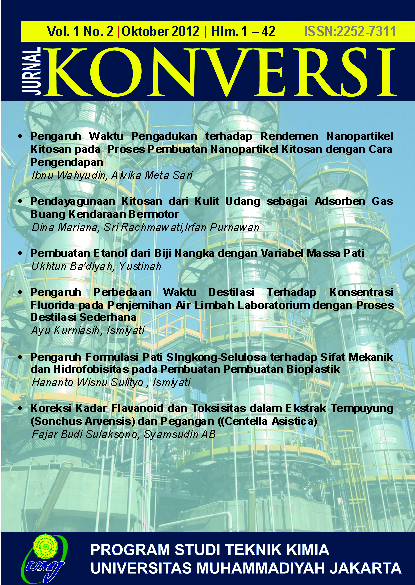PENGARUH FORMULASI PATI SINGKONG–SELULOSA TERHADAP SIFAT MEKANIK DAN HIDROFOBISITAS PADA PEMBUATAN BIOPLASTIK
Main Article Content
Abstract
Bioplastik merupakan plastik yang terbuat dari sumber yang dapat diperbaharui yaitu dari senyawa - senyawa dalam tanaman misalnya pati. Penggunaan pati sebagai bahan utama pembuatan plastik memiliki potensi yang besar karena di Indonesia terdapat berbagai tanaman penghasil pati seperti singkong, jagung, beras dan tanaman lainnya. Tujuan dari penelitian ini yaitu mengetahui temperatur gelatinisasi dan pengaruh formulasi pati-selulosa serta menentukan kondisi terbaiknya terhadap sifat mekanik dan ketahanan air bahan bioplastik. Dalam penelitian ini dilakukan studi mengenai pembuatan bioplastik campuran pati, selulosa dan gliserol sebagai plasticizer dengan melakukan variasi temperatur gelatinisasi yaitu pada T = 80o, 90o, dan 100oC serta variasi rasio massa antara pati dan selulosa yaitu 6:4, 7:3, 8:2, 9:1 dan 10:0 (m/m). Hasil yang diperoleh berupa lembaran tipis plastik (film plastic) yang diuji sifat mekaniknya dengan alat Universal Testing Machine serta uji ketahanan air (water uptake). Berdasarkan penelitian yang telah dilakukan didapatkan tingkat ketahanan air dan sifat fisik terbaik terdapat pada formulasi pati-selulosa 8:2 dan temperature gelatinasi 90°C dengan nilai penyerapan air sebesar 33 %, Tensile Strength 10.32 MPa, persen perpanjangan 27.91 % dan modulus young 36.97 Mpa. Kata kunci : Bioplastik, , gelatinisasi, hidrofobisitas, pati singkong, selulosa
Article Details
Issue
Section
Articles
Authors who publish with this journal agree to the following terms:
- Authors retain copyright and grant the journal right of first publication with the work simultaneously licensed under a Creative Commons Attribution License that allows others to share the work with an acknowledgement of the work's authorship and initial publication in this journal.
- Authors are able to enter into separate, additional contractual arrangements for the non-exclusive distribution of the journal's published version of the work (e.g., post it to an institutional repository or publish it in a book), with an acknowledgement of its initial publication in this journal.
- Authors are permitted and encouraged to post their work online (e.g., in institutional repositories or on their website) prior to and during the submission process, as it can lead to productive exchanges, as well as earlier and greater citation of published work (See The Effect of Open Access).
